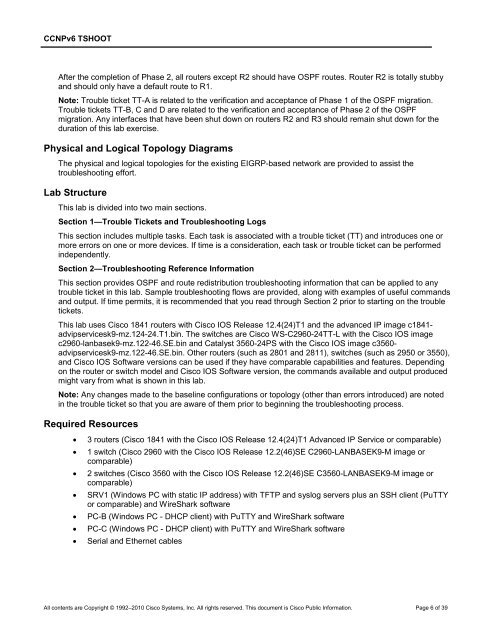CCNP TSHOOT 6.0 - The Cisco Learning Network
CCNP TSHOOT 6.0 - The Cisco Learning Network
CCNP TSHOOT 6.0 - The Cisco Learning Network
Create successful ePaper yourself
Turn your PDF publications into a flip-book with our unique Google optimized e-Paper software.
<strong>CCNP</strong>v6 <strong>TSHOOT</strong><br />
After the completion of Phase 2, all routers except R2 should have OSPF routes. Router R2 is totally stubby<br />
and should only have a default route to R1.<br />
Note: Trouble ticket TT-A is related to the verification and acceptance of Phase 1 of the OSPF migration.<br />
Trouble tickets TT-B, C and D are related to the verification and acceptance of Phase 2 of the OSPF<br />
migration. Any interfaces that have been shut down on routers R2 and R3 should remain shut down for the<br />
duration of this lab exercise.<br />
Physical and Logical Topology Diagrams<br />
<strong>The</strong> physical and logical topologies for the existing EIGRP-based network are provided to assist the<br />
troubleshooting effort.<br />
Lab Structure<br />
This lab is divided into two main sections.<br />
Section 1—Trouble Tickets and Troubleshooting Logs<br />
This section includes multiple tasks. Each task is associated with a trouble ticket (TT) and introduces one or<br />
more errors on one or more devices. If time is a consideration, each task or trouble ticket can be performed<br />
independently.<br />
Section 2—Troubleshooting Reference Information<br />
This section provides OSPF and route redistribution troubleshooting information that can be applied to any<br />
trouble ticket in this lab. Sample troubleshooting flows are provided, along with examples of useful commands<br />
and output. If time permits, it is recommended that you read through Section 2 prior to starting on the trouble<br />
tickets.<br />
This lab uses <strong>Cisco</strong> 1841 routers with <strong>Cisco</strong> IOS Release 12.4(24)T1 and the advanced IP image c1841advipservicesk9-mz.124-24.T1.bin.<br />
<strong>The</strong> switches are <strong>Cisco</strong> WS-C2960-24TT-L with the <strong>Cisco</strong> IOS image<br />
c2960-lanbasek9-mz.122-46.SE.bin and Catalyst 3560-24PS with the <strong>Cisco</strong> IOS image c3560advipservicesk9-mz.122-46.SE.bin.<br />
Other routers (such as 2801 and 2811), switches (such as 2950 or 3550),<br />
and <strong>Cisco</strong> IOS Software versions can be used if they have comparable capabilities and features. Depending<br />
on the router or switch model and <strong>Cisco</strong> IOS Software version, the commands available and output produced<br />
might vary from what is shown in this lab.<br />
Note: Any changes made to the baseline configurations or topology (other than errors introduced) are noted<br />
in the trouble ticket so that you are aware of them prior to beginning the troubleshooting process.<br />
Required Resources<br />
• 3 routers (<strong>Cisco</strong> 1841 with the <strong>Cisco</strong> IOS Release 12.4(24)T1 Advanced IP Service or comparable)<br />
• 1 switch (<strong>Cisco</strong> 2960 with the <strong>Cisco</strong> IOS Release 12.2(46)SE C2960-LANBASEK9-M image or<br />
comparable)<br />
• 2 switches (<strong>Cisco</strong> 3560 with the <strong>Cisco</strong> IOS Release 12.2(46)SE C3560-LANBASEK9-M image or<br />
comparable)<br />
• SRV1 (Windows PC with static IP address) with TFTP and syslog servers plus an SSH client (PuTTY<br />
or comparable) and WireShark software<br />
• PC-B (Windows PC - DHCP client) with PuTTY and WireShark software<br />
• PC-C (Windows PC - DHCP client) with PuTTY and WireShark software<br />
• Serial and Ethernet cables<br />
All contents are Copyright © 1992–2010 <strong>Cisco</strong> Systems, Inc. All rights reserved. This document is <strong>Cisco</strong> Public Information. Page 6 of 39

















